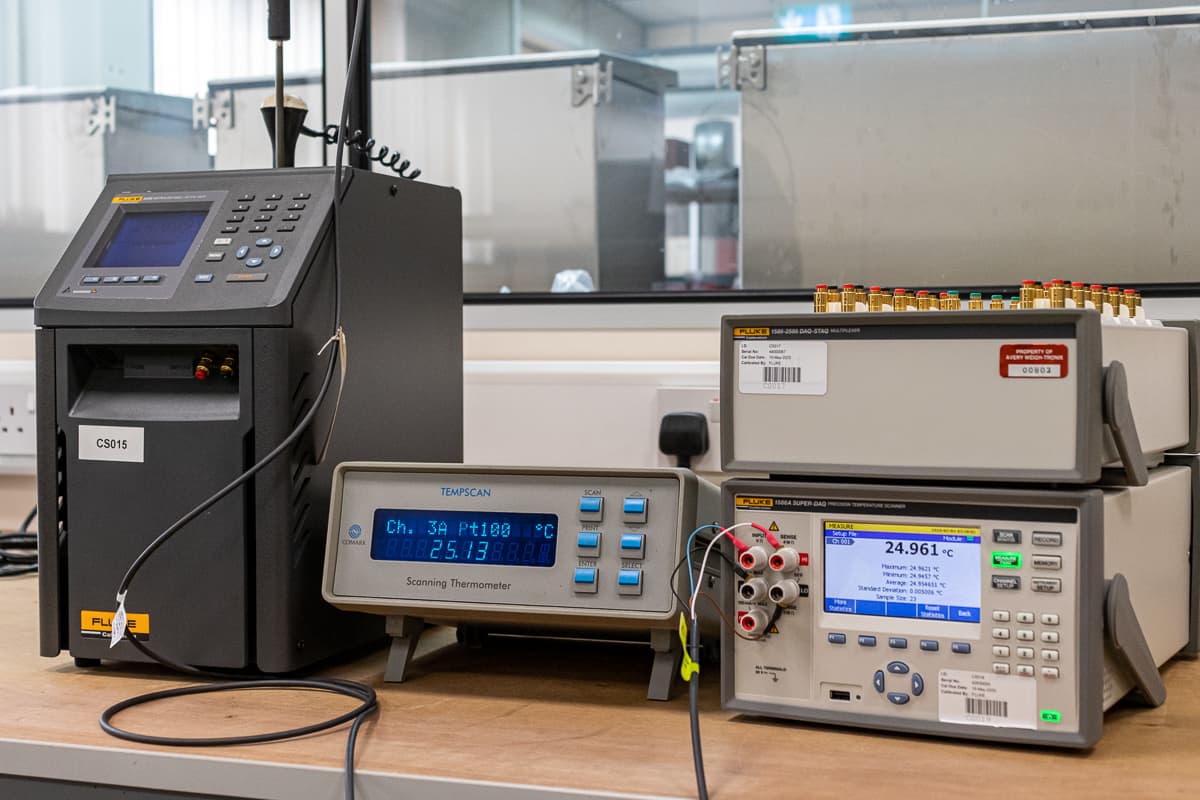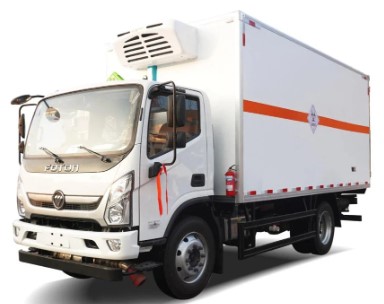
TEMPERATURE CALIBRATION
A temperature calibration laboratory requires equipment
such as stirred liquid baths and comparison furnaces, as well as measuring
equipment and accessories and, ideally, one or more ITS-90 fixed points, most
notably a Water Triple Point Cell.
Calibration of industrial temperature sensors is frequently more difficult than calibration of laboratory standards. Industrial sensors are frequently too short for calibration baths, may cover wide temperature ranges, and may require onsite calibration. We offer a variety of temperature sensor calibration solutions, as well as temperature equipment for secondary and primary laboratories.
Temperature
Calibration for Industrial Sensors
We have portable and larger bench equipment to generate
temperatures ranging from -196°C to 1300°C. We have reference thermometers and
measuring systems in addition to portable heat sources. Our temperature
calibration solutions are simple to expand and automate.
How We Can Assist
Learn more about our fast temperature calibrators,
portable liquid baths, and dry block calibrators, as well as our measuring
systems and automation software.
Temperature
Sources
Fast
Temperature Calibrators
The Dry Block, also known as a metal bock bath, block
bath, or simply a 'temperature calibrator,' is the most widely used industrial
temperature calibrator. When speed is critical, the Field block with a 25 mm
well can quickly reach and stabilise temperatures ranging from -35°C to 140°C.
The Quick Cal High and Quick Cal Low are two handheld Dry Blocks.
Multi-Function
Calibrators
Our calibrators have larger blocks but are still quick to
respond. They can be used as portable stirred liquid baths, or to calibrate
surface sensors, infrared thermometers, or even ITS-90 fixed points in addition
to being used as a Dry Block for PRT, thermocouple, and thermistor calibration.
Dry
Blocks
Liquids cannot be used at higher temperatures, so the Dry calibrators can be used to calibrate all sensor types, including RTDs, PRTs, Dial Thermometers, Thermocouples, and Thermistors, from 35°C to 700°C. There are standard inserts with pockets to fit a variety of temperature sensors, and we can design and manufacture custom inserts to meet your specifications.
Reference
Standards and Measuring Instruments
Reference
Thermometers
True laboratory standards, such as the Standard Platinum
Resistance Thermometer (SPRT), are far too delicate for industrial use. Our
"Semi-Standard" PRTs are specifically designed to calibrate
industrial thermometers; they are metal sheathed, less fragile, and less
expensive than SPRTs. We also have Semi Standard Thermocouples, which can cover
the temperature range from -200°C to 1300°C.
Measuring
Instruments
Many calibrators include temperature readouts for
reference thermometers. Precision Thermometers with accuracies to 0.001°C, as
well as handheld and portable high accuracy bench thermometers, are available.
Our bench thermometer is compatible with all sensor types, including SPRTs,
PRTs, Thermocouples, and Thermistors, and can be easily expanded for
multi-channel operation.
Automating
Temperature Calibration
Our temperature calibration software can control
calibrators and instruments, step through a series of temperature calibration
points automatically, and log calibration results. The software can calculate
temperature calibration coefficients and correction tables in addition to
printing calibration certificates for industrial thermometers.
Industrial
Calibration
Help and advice to find the product you need
Support with calibration of industrial sensors
Case Studies
Calibration certificates
On-Site Temperature Calibration
In many ways, those calibrating temperature sensors
on-site have a more difficult job than those calibrating thermometers in the
laboratory. We have a variety of
solutions for all users; here, we review some popular solutions for site
calibration engineers.
Steriliser and Autoclave Validation (Temperature
Validation Equipment)
History tells us that regulations and compliance requirements are constantly evolving. This is especially true for the pharmaceutical and health industries as improved technologies and practices appear on the horizon.
In this guide we are addressing the choice of temperature calibration equipment available to enable the site calibration engineer to provide local maintenance for autoclaves and sterilisers, generally used but not exclusively by hospitals.
“Thermometric tests use accurate measuring equipment to
monitor temperatures and pressures independently of the instruments fitted to
the steriliser. They provide the assurance that the temperature requirements
for sterilisation are met”
The calibration of all instruments should be verified yearly by using reference instruments with a valid certificate of calibration traceable to a national standard”
“An independent temperature reference source (a hot source) is required, with a pocket to accommodate up to 12 temperature sensors. The temperature gradient should not exceed 0.2°C and the control accuracy should be within ±0.1°C over the relevant sterilisation temperature band.”
Chamber
Mapping
Pharmacuetical, food and beverage, and healthcare
industries routinely use climatic storage facilities for their products.
These storage "chambers" will typically house
products that require precise control and monitoring of their physical state,
such as blood storage, frozen foods, and medicines. This will generally help to improve the shelf
life of the product.
The chambers are typically benchtop or floor standing
devices, though larger, walk-in chambers for large scale storage can also be
found. Furthermore, humidity measurements are frequently used in conjunction
with temperature measurements.
As a result, the chambers must be validated as fit for
purpose and must adhere to often stringent regulations.
Here we show two common configurations widely used by
most calibration engineers and illustrate the equipment needed for validating
the chamber temperature.
OPTION 1:
Dataloggers Between Use
Dataloggers are available in a variety of sizes and
shapes, ranging from small "coin" shaped devices to credit card sized
devices. These data loggers must be calibrated. There are several approaches
that can be taken, but we recommend starting from the ground up.
We will perform a Comparison Calibration using the Zeroth
Law of Thermodynamics and immerse these loggers in a liquid medium alongside an
ENAS calibrated, traceable reference probe.
The Hyperion "wide aperture (65mm)" temperature
calibrator can be used for this. The dataloggers are immersed in liquid, the
temperature of which is precisely controlled by a high precision PID
controller.
Option 2: Realtime Monitoring
We are increasingly being asked for a solution for
"monitoring" the chamber in real time with more accurate sensors.
A common approach in this scenario is to insert multiple
certified sensors through the chamber's wall. These sensors can be directly
connected to a precision thermometer, and their data can be collected for later
reporting.
PRTs or Thermocouples (for higher temperatures) can be
used as these sensors. We can also provide the proper sensor for your
temperature range.
Calibration
of Temperature Switches
Temperature switches are used in a wide range of
applications, from catering ovens and home thermostats to chemical processes
and hotel room air conditioning.
A temperature sensor in a thermostat is programmed to
make a change at a specific temperature.
We will demonstrate the equipment needed to accurately test this
function and provide a calibration here.
Principle
of Calibration
When a temperature switch is activated, it completes a
circuit. If the sensor becomes too hot, this circuit can initiate a cooling
device or send an alarm signal to a control panel.
When activated, the electrical contact in the switch will
be in one of two states: "normally open" or "normally
closed."
To test this switch point, we must gradually increase the
temperature past the activation point in order to determine the temperature of
activation. How are we going to accomplish this?
Equipment
Here at, we help our customers select the best equipment for controlling this ramp. A dry-well temperature calibrator is recommended for a typical catering oven.
The temperature sensor will be tested in the dry-well,
which will also house a UKAS-certified reference probe. A temperature ramp is
then programmed into the system to take the sensor through its activation
range.
It is obvious that if the ramp occurs too quickly, we
will overshoot the switch point and the recorded temperature of switching will
be inaccurate. This is why our dry-wells use world-class PID control. We can
not only set the control ramp rate to 0.01°C per minute, but we can also tell
the controller whether the sensor under test is normally open or normally
closed at the start of the ramp. When the switch point is reached, the display
"freezes," which is useful if the calibration engineer is
multitasking and isn't sitting next to the drywell at the time.
Furthermore, our customers will test this switch point
activation on a regular basis by ramping up and ramping down.
High
Temperature Site Testing
The site engineer is frequently called upon to calibrate
sensors that monitor high temperatures. Pyrometry and Infrared Imaging devices
can provide a safe check from outside the hot environment, but how do we
"replicate" the temperature conditions that the monitoring sensor is
subjected to during normal operation?
For this, we have a solution.
The thermal imager can calibrate the furnace temperature
for temperatures up to 1200°C.
Calibration and repair of the following instruments
Fluke 714 Thermocouple Calibrator
Fluke 724 Temperature Calibrator
Fluke 754 Documenting Process Calibrator-HART
Fluke 724 Temperature Calibrator
Fluke 714B Thermocouple Calibrator
Fluke 712B RTD Calibrators
Fluke 725 Multifunction Process Calibrator
Fluke 753 Documenting Process Calibrator
Fluke 1551a Stik Thermometer & Temperature Calibrator
Fluke Calibration 1523 Handheld Thermometer Readout
Fluke Calibration 9103/9140 Field Dry-Well
Fluke Calibration 9142 Field Metrology Well
Fluke Calibration 9143 Field Metrology Well
Fluke Calibration 9144 Metrology Well
Fluke 9190A Ultra-Cool Field Metrology Well
Fluke Calibration 1524 Handheld Thermometer Readout
Fluke Calibration 4180/4181 Precision IR Calibrators
Fluke 9132/9133 Portable Infrared Calibrator
Hart 5610, 5611A, 5611T, 5665 Secondary Reference
Thermistor Probes
Beamex POC8
Beamex CENTRiCAL
Beamex MB
Beamex FB
Beamex temperature sensors
Beamex MC6-Ex
TEMPERATURE PROBE CALIBRATION:
MUST be supplied with indicator. (Calibrated through
immersion only)
BASE METAL AND NOBLE METAL THERMOCOUPLES
2, 3 AND 4 WIRE PRTS
HUMIDITY PROBES & SENSORS
THERMISTORS
Benefits of having your electrical equipment calibrated
at our laboratory:
International standard calibrations
All of our temperature calibrations are relevant to
International Temperature Scale (ITS-90) standard
TEMPERATURE INDICATOR CALIBRATION (NO PROBE):
(Calibrated through electrical simulation)
DIGITAL THERMOMETERS
INFRARED THERMOMETERS
TEMPERATURE CONTROLLERS
Calibration / Digital Readout
TEMPERATURE INDICATORS
TEMPERATURE / HUMIDITY DATA LOGGERS
ON-SITE TEMPERATURE CALIBRATIONS:
In addition to those above, we can calibrate the
following at your premises:
CHART RECORDERS
ENVIRONMENTAL CHAMBERS
Basic calibration or a Temperature Uniformity Survey
(TUS)
FREEZERS
Basic calibration or a Temperature Uniformity Survey
(TUS)
FURNACES
Basic calibration or a Temperature Uniformity Survey
(TUS)
HMIS
HUMIDITY CABINETS
HUMIDITY PROBES
HYGROMETERS
INCUBATORS
OVENS
Basic calibration or a Temperature Uniformity Survey
(TUS)
PLCS
REFRIGERATORS
Basic calibration or a Temperature Uniformity Survey
(TUS)
SALT CHAMBERS
Basic calibration or a Temperature Uniformity Survey
(TUS)
TEMPERATURE CONTROLLERS
TEMPERATURE PROBES
THERMOCOUPLES
Oven/Furnace Uniformity Surveys and calibration
Psychrometer Calibration – Dew Point, Sling
Pyrometer Calibration
Recorder Calibration
Chart Temperature
Digital Temperature
Humidity (Dial Type), Temperature and Humidity
System Accuracy Tests
Temperature Uniformity Test
Temperature Controllers/Digital Readout Calibration
RTD Probe Calibration (ITS-Coefficient)
Thermocouple Calibration
No readout and module
NIST Thermocouple Calibration
B Type Thermocouple Calibration
E Type Thermocouple Calibration
J Type Thermocouple Calibration
K Type Thermocouple Calibration
R Type Thermocouple Calibration
S Type Thermocouple Calibration
T Type Thermocouple Calibration
Base Metal Thermocouple Calibration
Noble Metal Thermocouple Calibration
Thermocouple Sensor Calibration
Dry Block Calibrators & Baths Calibration
Dry Block Calibrator Calibration
Temperature Dry Block Calibrator Calibration
Field Dry Block Calibrator Calibration
Micro Bath Calibration
Dry Well Temperature Calibrator Calibration
Metrology Dry Well Calibration
Dry Well Calibrator Calibration
Liquid Bath Temperature Calibrator Calibration
Temperature Bath Calibration




